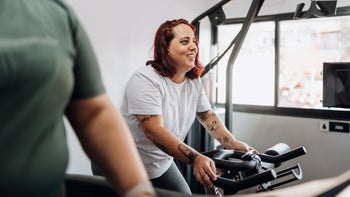
8 Easy Hamstring Stretches You Can Do Anywhere
Key takeaways:
Tight hamstrings can limit your mobility and increase your risk of injuries.
Both intense workouts and inactivity can cause tight hamstrings.
You can stretch your hamstrings while standing, sitting, or lying down to relieve uncomfortable stiffness.
Table of contents

You’ve probably felt the pull of tight hamstrings at some point. Numerous activities –– from running a marathon to sitting at a desk all day –– can cause these muscles to tighten up.
Your hamstrings consist of three muscles along the back of your thigh. They run from the bottom of your pelvis to the bottom of your knee. This key muscle group works in opposition to the quadricep muscles at the front of your thigh. By allowing you to bend your knees and extend your hips, your hamstrings help you walk, run, and jump. But, because you rely on your hamstrings for these everyday movements, they may be prone to stiffness.
Fortunately, simple hamstring stretches can relieve or prevent tightness and increase flexibility.
Search and compare options
Simple hamstring stretches for tight muscles
Stretching is a simple yet effective way to release tight hamstrings. Both static and dynamic stretches can increase hamstring flexibility. Doing a complete stretching routine before and after exercise can also help prevent muscle soreness and promote muscle recovery. Plus, keeping your hamstrings loose and flexible will help you stay mobile and ready for everything from sports to everyday activities.
These seven hamstring stretches can help you get started. But be sure to consult your healthcare provider before trying new exercises.
1. Supine hamstring stretch
The supine hamstring stretch is a gentle way to loosen your muscles.
Step 1: Lie on your back with your knees bent and your feet flat on the floor. As your flexibility improves, you can straighten one leg on the floor while bending the other leg at the knee.
Step 2: Straighten your right leg up toward the ceiling.
Step 3: Slowly pull your right leg toward your chest. You can keep your leg straight or bend it slightly at the knee.
Step 4: Gently grab your calf below the knee or your thigh above the knee to deepen the stretch. Or use an exercise strap looped over the sole of your right foot. If you’re using a strap, hold the ends of it in each hand and gently pull your leg toward your chest.
Step 5: Hold the stretch for 15-30 seconds. Then, lower your leg to the starting position.
Step 6: Switch legs and repeat.
Step 7: Do this 2-3 times for each leg.
2. Doorway hamstring stretch
The doorway stretch lengthens your hamstrings and may reduce strain on your lower back.
Step 1: Lie on your back with your sit bones centered a few inches from the right side of an open doorway. Bend your knees and keep your feet flat on the floor.
Step 2: Keep your left leg bent and extend your right leg up. Place your right sole or heel against the wall to the right of the doorway or along the doorjamb.
Step 3: Move a few inches away from the doorway if the stretch is too intense.
Step 4: Hold the stretch for 15-30 seconds.
Step 5: Extend your left leg, placing it straight through the doorway to deepen the stretch.
Step 6: Repeat 2-3 times with each leg.
3. Modified hurdler hamstring stretch
You can engage your hamstrings, hip flexors, and inner thigh muscles with the modified hurdler hamstring stretch.
Step 1: Sit upright on the floor with your back upright and your left leg extended straight.
Step 2: Bend your right knee, placing the sole of your right foot against your inner left thigh.
Step 3: Fold at the waist and reach your hands toward your left leg.
Step 4: Hold the position for 15-30 seconds.
Step 5: Switch legs and repeat.
Step 6: Repeat 2-3 times on each side.
Read more like this
Explore these related articles, suggested for readers like you.
4. Seated forward bend
At first glance, the seated forward bend might look simple. But it can provide a gentle yet deep stretch for your hamstrings and calves.
Step 1: Sit on the floor with your back upright and your legs extended straight.
Step 2: Inhale and reach your arms straight up.
Step 3: Exhale and slowly fold at the waist, bringing your torso to rest on your thighs. Keep your knees straight and your arms extended, reaching as far as you can toward your ankles or feet.
Step 4: Grab your ankles, feet, or calves — whichever you can reach. You should feel a gentle stretch in your hamstrings.
Step 5: Hold the position for 15-30 seconds.
Step 6: Repeat the stretch 3 times.
5. Standing toe touch
The standing toe touch is another seemingly simple stretch that can pack a punch. It engages your abdominals and stretches your hamstrings and calves.
Step 1: Stand tall with your shoulders back and your back straight.
Step 2: Inhale as you hinge at the hips, folding forward to reach toward your toes. Reach as far as you can while keeping your knees straight.
Step 3: Exhale and stretch deeper, touching your toes or holding your ankles.
Step 4: Hold the stretch for 15-30 seconds.
Step 5: Slowly return to standing.
Step 6: Repeat the stretch 3 times.
6. Standing hamstring stretch
With the crossed-leg standing hamstring stretch, you engage the hamstrings in both legs at the same time.
Step 1: Stand up straight and cross your right foot in front of your left to deepen the stretch in your left leg. If this is too intense, you can keep your feet flat on the floor for a gentler stretch.
Step 2: Slowly bend at the waist, lowering your forehead toward your right knee. Try to keep your knees straight. You should feel the stretch in your right and left legs.
Step 3: Hold the position for 15-30 seconds before returning to standing.
Step 4: Cross your left foot in front of your right and repeat.
Step 5: Repeat 2-3 times with each leg.
7. Downward-facing dog
Practicing yoga is a great way to increase your flexibility. And downward dog is a go-to position for flexibility. It lengthens your spine and stretches your hamstrings, calves, and arms.
Step 1: Kneel on all fours with your wrists directly under your shoulders and your knees under your hips. Tuck your toes and lift your heels.
Step 2: Press your palms into the floor to lift your knees and raise your hips toward the ceiling.
Step 3: Straighten your legs as you press your heels into the floor. Your body will make an upside-down V shape.
Step 4: Hold the pose. Keep your neck and spine neutral, and try not to lock your elbows or knees.
Step 5: Slowly lower your knees toward the floor to release the pose. Return to the starting position.
8. Hamstring foam rolling
Foam rolling exercises can help reduce muscle tightness and promote exercise recovery. Try this hamstring roll to reduce soreness and tension.
Step 1: Sit upright on the floor with your legs extended. Put a foam roller under your hamstrings.
Step 2: Press your palms on the floor just behind your hips. Then press your body weight into the foam roller and push your butt backward to slide the foam roller along the back of your thighs. Keep it above your knees.
Step 3: Slide the foam roller back up to the starting position.
Step 4: Keep moving the foam roller up and down the backs of your thighs for 30-60 seconds. Pause over any particularly tense or tender spots.
What causes tight hamstrings?
Tight hamstrings may cause stiffness and soreness that limit your mobility. Common causes of tight hamstrings include:
New or vigorous exercise: New or higher-intensity exercise can cause hamstring muscles to tighten or be sore. This is especially true for exercises that stress your hamstrings, such as squats, sprints, and weightlifting.
Overuse: Overusing muscles during sports and other activities that involve repetitive movements may tighten your hamstrings. Examples include cycling, long-distance running, tennis, and soccer.
Prolonged sitting: Believe it or not, inactivity can also lead to tight hamstrings. When you sit for prolonged periods, especially with poor posture, your hamstrings flex and shorten, making them stiff when you stand.
Muscle weakness: There’s truth to the idea that if you don’t use it, you lose it. Inactivity, including too much sitting, can weaken your glutes and hip flexors. When these muscles are weak, your hamstrings work even harder to compensate, making them more prone to tightness and injury.
Muscle strain or other hamstring injuries: Tight hamstrings shouldn’t be confused with muscle strain or other hamstring injuries that cause more severe symptoms. Previous hamstring injuries can also make you more susceptible to stiff hamstrings.
Is it good to stretch a sore hamstring?
It depends on your symptoms. If you have tight or mildly sore hamstrings after prolonged inactivity or a workout, some gentle stretches may help reduce muscle stiffness.
But it could be a sign of injury if you have acute or sudden pain in your hamstrings –– especially during exercise, sports, or other physical activities. If this is the case, it’s best to skip stretching and other home remedies and talk to your healthcare provider. You should also talk to your provider if mild symptoms worsen or don't improve in a week.
How can you tell if your hamstring is tight, torn, or pulled?
You might notice minor muscle aches, tenderness, and stiffness when your hamstrings are tight. These symptoms could be a sign of delayed onset muscle soreness (DOMS) or a mild muscle strain or pull. Strains occur when you overload or overstretch a muscle.
Symptoms of DOMS or a mild hamstring strain usually improve with self-care, such as rest, ice, stretching, and strengthening exercises. And they often resolve after a few days.
But, because tight hamstrings are prone to injuries, your symptoms could indicate more serious issues. This includes a partial or complete hamstring tear. In those cases, you might experience more severe symptoms, such as:
Sudden, sharp pain in the back of your thighs
Swelling shortly after injury
Hamstring muscle weakness that lasts for weeks
Bruising or discoloration at the back of your thigh or lower leg
Difficulty standing, walking, or moving the affected muscles
Talk to your healthcare provider if your symptoms last longer than a week. And seek immediate medical attention if you can't walk or move the affected leg.
The bottom line
The tug of tight hamstrings can make it challenging to exercise or perform daily tasks. But there are stretching exercises designed to relieve tightness. Adding hamstring stretches to your fitness routine can help you feel more agile and reduce your risk of injuries.
Why trust our experts?



References
Alaia, M. J., et al. (2021). Hamstring muscle injuries. OrthoInfo.
American Council on Exercise. (n.d.). Downward-facing dog.
Chen, C. H., et al. (2015). Acute effects of static active or dynamic active stretching on eccentric-exercise-induced hamstring muscle damage. International Journal of Sports Physiology and Performance.
Fatima, G., et al. (2017). Extended sitting can cause hamstring tightness. Saudi Journal of Sports Medicine.
FitnessBlender. (2010). Standing toe touch stretch [video]. YouTube.
Mayo Clinic. (2017). Wellness Wednesday: Use a foam roller to release your hamstrings [video]. YouTube.
Medeiros, D. M., et al. (2016). Influence of static stretching on hamstring flexibility in healthy young adults: Systematic review and meta-analysis. Physiotherapy Theory and Practice.
Mount Sinai. (n.d.). Hamstring strain - aftercare.
Origym Personal Trainer Courses. (2021). How to do standing crossed leg hamstring stretch | Stretching demo [video]. YouTube.
Pain Therapy. (2012). Seated hamstring stretch 2 [video]. YouTube.
Poudel, B., et al. (2023). Hamstring injury. StatPearls.
Providence. (2017). Doorway stretch [video]. YouTube.
Rehab My Patient. (2014). How to do a hamstring stretch 9 bent knee [video]. YouTube.
Rodgers, C. D., et al. (2023). Anatomy, bony pelvis and lower limb, hamstring muscle. StatPearls.
ScienceDirect. (n.d.). Delayed onset muscle soreness.
Takeuchi, K., et al. (2021). The acute effects of high-intensity jack-knife stretching on the flexibility of the hamstrings. Scientific Reports.
The Art of Living. (2018). Paschimottanasana | Seated forward bend yoga pose | Steps | Benefits | Yogic fitness [video]. YouTube.
Zulaini, et al. (2021). Effect stretching and recovery on delayed onset muscle soreness (DOMS) after exercise. Journal of Physics: Conference Series.



























